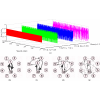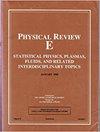Dispersion network-transition entropy: A metric for characterizing the complexity of nonlinear signals
IF 2.4
3区 物理与天体物理
Q1 Mathematics
引用次数: 0
Abstract
Extracting meaningful information from signals has always been a challenge. Due to the influence of environmental noise, collected signals often exhibit nonlinear characteristics, rendering traditional metrics inadequate in capturing the dynamic properties and complex structures of signals. To address this challenge, this study proposes an innovative metric for quantifying signal complexity—dispersion network-transition entropy (DNTE), which integrates the concepts of complex networks and information entropy. Specifically, we assign single cumulative distribution function values to network nodes and utilize Markov chains to represent links, transforming nonlinear signals into weighted directed complex networks. Subsequently, we assess the importance of network nodes and links, and employ the mathematical expression of information entropy to calculate the DNTE value, quantifying the complexity of the original signal. Next, through extensive experiments on simulated chaotic models and real underwater acoustic signals, we confirm the outstanding performance of DNTE. The results indicate that, compared to Lempel-Ziv complexity, permutation entropy, and dispersion entropy, DNTE not only more accurately reflects changes in signal complexity but also exhibits higher computational efficiency. Importantly, DNTE demonstrates optimal performance in distinguishing different categories of chaotic models, ships, and modulation signals, showcasing its significant potential in extracting effective information from signals.

分散网络-转换熵:表征非线性信号复杂性的指标
从信号中提取有意义的信息一直是一项挑战。由于受环境噪声的影响,采集到的信号往往表现出非线性特征,使得传统的度量方法无法捕捉信号的动态特性和复杂结构。为了应对这一挑战,本研究提出了一种量化信号复杂性的创新指标--分散网络-转换熵(DNTE),它整合了复杂网络和信息熵的概念。具体来说,我们为网络节点分配单一累积分布函数值,并利用马尔可夫链来表示链接,从而将非线性信号转化为加权有向复杂网络。随后,我们评估网络节点和链接的重要性,并利用信息熵的数学表达式计算 DNTE 值,量化原始信号的复杂性。接下来,通过对模拟混沌模型和真实水下声学信号的大量实验,我们证实了 DNTE 的卓越性能。结果表明,与 Lempel-Ziv 复杂度、置换熵和分散熵相比,DNTE 不仅能更准确地反映信号复杂度的变化,而且具有更高的计算效率。重要的是,DNTE 在区分不同类别的混沌模型、舰船和调制信号方面表现出最佳性能,展示了其在从信号中提取有效信息方面的巨大潜力。
本文章由计算机程序翻译,如有差异,请以英文原文为准。
求助全文
约1分钟内获得全文
求助全文
来源期刊

Physical review. E
物理-物理:流体与等离子体
CiteScore
4.60
自引率
16.70%
发文量
0
审稿时长
3.3 months
期刊介绍:
Physical Review E (PRE), broad and interdisciplinary in scope, focuses on collective phenomena of many-body systems, with statistical physics and nonlinear dynamics as the central themes of the journal. Physical Review E publishes recent developments in biological and soft matter physics including granular materials, colloids, complex fluids, liquid crystals, and polymers. The journal covers fluid dynamics and plasma physics and includes sections on computational and interdisciplinary physics, for example, complex networks.
 求助内容:
求助内容: 应助结果提醒方式:
应助结果提醒方式:


